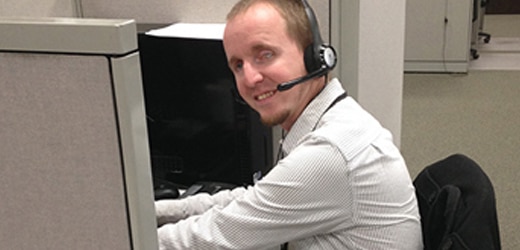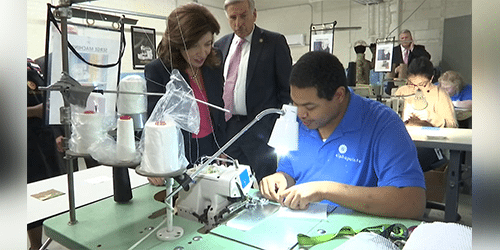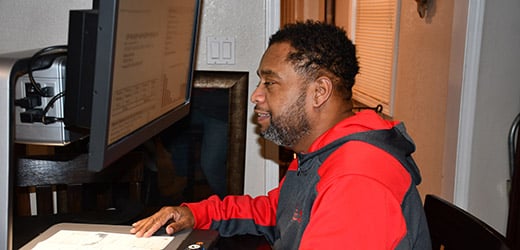Through Our Eyes: On Being Thankful

I suppose it wouldn’t be entirely accurate to say that blindness itself has come a long way. Someone who was completely blind in the 19th or 20th century would be just as blind in 2025. What has come a long way is the quality of life and level of independence available to blind people today.
Once upon a time, a blind person might have been someone struggling to survive. Ignored and without prospects, with little or no real hope for employment or a family life. By the 20th century we began to see famous blind musicians and performers, yet the average blind person still struggled to be independent, earn a living, or start themselves a family.
Now, in 2025, I feel like the blind and visually impaired community has much for which to be thankful.
Facing Vision Loss as a Youth
Let’s be honest: being a teenager is rough. Teens are just starting to figure out who they are, all while juggling school, friendships, family and, oftentimes, the drama of early romance. Add in all the usual awkwardness and, on top of that, imagine being visually impaired or completely blind. I lived that life as a teenage boy with low vision, and trust me, it can feel like a minefield, especially if you’re one of the only students with vision loss in your school or friend group.
Fortunately, today’s visually impaired youth have far more opportunities than were available just a few decades ago. Technology has advanced dramatically, making it easier for students with vision loss to be seamlessly integrated into the classroom. Paraprofessionals, TVIs (teachers of the visually impaired), Braillists, and O&M instructors (orientation and mobility) have become essential parts of modern education, making learning and socializing far more accessible.

Schools aren’t the only thing that have improved. Youth programs specifically designed for kids with vision loss now exist across the country. Organizations like Alphapointe and many others offer year-round activities where kids can socialize with others who truly understand them, participating in programs built around their needs, strengths, and interests.
Adulting With Vision Loss
Being an independent adult is challenging even on a good day. Add in a visual impairment or blindness and it can feel overwhelming. It doesn’t have to be.
Don’t get me wrong: being an adult with vision loss can definitely be messy at times (literally and figuratively). But thanks to modern technology, rehabilitation programs, employment opportunities like those offered at Alphapointe, and strong advocacy groups, life has become far more manageable.
But thanks to modern technology, rehabilitation programs, employment opportunities like those offered at Alphapointe, and strong advocacy groups, life has become far more manageable.
If you’re an adult with vision loss trying to find employment or live independently for the first time, organizations like Alphapointe can teach essential independent-living skills and help you find meaningful work.

Once you’re on your own, most household tasks can be handled with auditory or tactile aids … even through a few taps on a phone app. I still remember getting my first talking cell phone less than 20 years ago. You had to install special software that no one at the phone store had ever heard of, and even then, half the apps weren’t accessible. Now, nearly every smartphone has a built-in screen reader, and most apps are fully accessible.
There are apps for identifying currency, reading labels, describing clothing, and even connecting you with a live person for assistance through video. There are accessible apps for hobbies, games, reading, sports, and listening to music. High-tech and low-tech tools exist for cooking, cleaning, managing mail, organizing finances, and picking out clothes, all of which can make independent living far easier.
Text-enlargement and screen-reading programs for computers and laptops mean that people with vision loss can perform work tasks, browse the web, check email, use social media, and more.
Most major cities now have accessible infrastructure, including talking and Braille-labeled crosswalks and Braille signage in public buildings. Public transportation options are often usable, and when they’re not, many cities offer discounted or free ride services. And of course, Uber and Lyft are fully accessible.

Thanks to all these advancements, plus many more we don’t even have room to list, adults with vision loss are pursuing college degrees and working in fields from manufacturing to tech support, media, massage therapy, law, and beyond.
How Far We’ve Come
Living with vision loss can be stressful or even scary at times. It can cause anxiety, and that’s okay. It isn’t weakness, and it’s completely normal to feel that way. But the blind and visually impaired community, along with countless advocacy organizations, have made incredible strides just within my lifetime. The avalanche of technology, resources, and support systems available to anyone who reaches out has made it possible for people with vision loss to live richer, more independent, more fulfilling lives than ever before.
In my opinion, though, the most powerful resource – the most valuable tool a visually impaired person can carry – is a positive attitude and an optimistic outlook. After 37 years of living with vision loss, I can confidently say: we truly have a lot to be thankful for.





